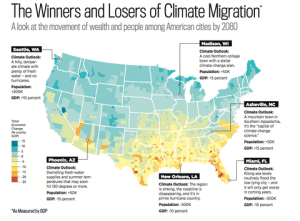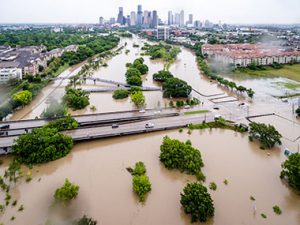So, tree deaths in the western U.S. have more than doubled over the last few decades, and the most obvious cause is rising regional temps due to global warming. But…
When questioned about the most pressing issues facing the country, poll respondents in the same U.S. rank concern about global warming dead last. Hmm, the coincidence is lifting into a fog, enveloping our ability to discern among our crises. The old saw about about ‘if a tree falls in the woods and no one is there to hear it, does it make a sound?’ is seamlessly seguing into something along the lines of ‘if the woods all fall together and everyone sees it, will it make any difference?’
But… it’s Friday, when I usually offer some kind of contextual reading. So how about a snippet from Aldo Leopold‘s The Land Ethic? Here’s a section, Substitutes for a Land Ethic, to consider:
When the logic of history hungers for bread and we hand out a stone, we are at pains to explain how much the stone resembles bread. I now describe some of the stones which serve in lieu of a land ethic.
One basic weakness in a conservation system based wholly on economic motives is that most members of the land community have no economic value. Wildflowers and songbirds are examples. Of the 22,000 higher plants and animals native to Wisconsin, it is doubtful whether more than 5 per cent can be sold, fed, eaten, or otherwise put to economic use. Yet these creatures are members of the biotic community, and if (as I believe) its stability depends on its integrity, they are entitled to continuance.
When one of these non-economic categories is threatened, and if we happen to love it, we invent subterfuges to give it economic importance. At the beginning of the century songbirds were supposed to be disappearing. Ornithologists jumped to the rescue with some distinctly shaky evidence to the effect that insects would eat us up if birds failed to control them. The evidence had to be economic in order to be valid.
It is painful to read these circumlocutions today. We have no land ethic yet, but we have at least drawn nearer the point of admitting that birds should continue as a matter of biotic right, regardless of the presence or absence of economic advantage to us.
A parallel situation exists in respect of predatory mammals, raptoral birds, and fish-eating birds. Time was when biologists somewhat overworked the evidence that these creatures preserve the health of game by killing weaklings, or that they control rodents for the farmer, or that they prey only on ‘worthless’ species. Here again, the evidence had to be economic in order to be valid. It is only in recent years that we hear the more honest argument that predators are members of the community, and that no special interest has the right to exterminate them for the sake of a benefit, real or fancied, to itself. Unfortunately this enlightened view is still in the talk stage. In the field the extermination of predators goes merrily on: witness the impending erasure of the timber wolf by fiat of Congress, the Conservation Bureaus, and many state legislatures.
Some species of trees have been ‘read out of the party’ by economics-minded foresters because they grow too slowly, or have too low a sale value to pay as timber crops: white cedar, tamarack, cypress, beech, and hemlock are examples. In Europe, where forestry is ecologically more advanced, the non-commercial tree species are recognized as members of the native forest community, to be preserved as such, within reason. Moreover some (like beech) have been found to have a valuable function in building up soil fertility. The interdependence of the forest and its constituent tree species, ground flora, and fauna is taken for granted.
Lack of economic value is sometimes a character not only of species or groups, but of entire biotic communities: marshes, bogs, dunes, and ‘deserts’ are examples. Our formula in such cases is to relegate their conservation to government as refuges, monuments, or parks. The difficulty is that these communities are usually interspersed with more valuable private lands; the government cannot possibly own or control such scattered parcels. The net effect is that we have relegated some of them to ultimate extinction over large areas. If the private owner were ecologically minded, he would be proud to be the custodian of a reasonable proportion of such areas, which add diversity and beauty to his farm and to his community.
In some instances, the assumed lack of profit in these ‘waste’ areas has proved to be wrong, but only after most of them had been done away with. The present scramble to reflood muskrat marshes is a case in point.
There is a clear tendency in American conservation to relegate to government all necessary jobs that private landowners fail to perform. Government ownership, operation, subsidy, or regulation is now widely prevalent in forestry, range management, soil and watershed management, park and wilderness conservation, fisheries management, and migratory bird management, with more to come. Most of this growth in governmental conservation is proper and logical, some of it is inevitable. That I imply no disapproval of it is implicit in the fact that I have spent most of my life working for it. Nevertheless the question arises: What is the ultimate magnitude of the enterprise? Will the tax base carry its eventual ramifications? At what point will governmental conservation, like the mastodon, become handicapped by its own dimensions? The answer, if there is any, seems to be in a land ethic, or some other force which assigns more obligation to the private landowner.
Industrial landowners and users, especially lumbermen and stockmen, are inclined to wail long and loudly about the extension of government ownership and regulation to land, but (with notable exceptions) they show little disposition to develop the only visible alternative: the voluntary practice of conservation on their own lands.
When the private landowner is asked to perform some unprofitable act for the good of the community, he today assents only with outstretched palm. If the act costs him cash this is fair and proper, but when it costs only forethought, open-mindedness, or time, the issue is at least debatable. The overwhelming growth of land-use subsidies in recent years must be ascribed, in large part, to the government’s own agencies for conservation education: the land bureaus, the agricultural colleges, and the extension services. As far as I can detect, no ethical obligation toward land is taught in these institutions.
To sum up: a system of conservation based solely on economic self-interest is hopelessly lopsided. It tends to ignore, and thus eventually to eliminate, many elements in the land community that lack commercial value, but that are (as far as we know) essential to its healthy functioning. It assumes, falsely, I think, that the economic parts of the biotic clock will function without the uneconomic parts. It tends to relegate to government many functions eventually too large, too complex, or too widely dispersed to be performed by government.
An ethical obligation on the part of the private owner is the only visible remedy for these situations.



 Imagine there’s a video game, where the player must decide which tools to use to dig themselves out a hole without acknowledging that holes exist OR that the player is trapped in one and hence needs the tools. The point of the game (beyond your apparent need to never face 30 contiguous seconds of not looking at your phone) is to let players experience what it feels like to be a member of the
Imagine there’s a video game, where the player must decide which tools to use to dig themselves out a hole without acknowledging that holes exist OR that the player is trapped in one and hence needs the tools. The point of the game (beyond your apparent need to never face 30 contiguous seconds of not looking at your phone) is to let players experience what it feels like to be a member of the  Include our brains. This report about Houston from last year outlines how unchecked development remains a priority in the famously un-zoned city, creating short-term economic gains for some while
Include our brains. This report about Houston from last year outlines how unchecked development remains a priority in the famously un-zoned city, creating short-term economic gains for some while 